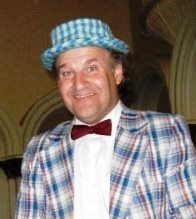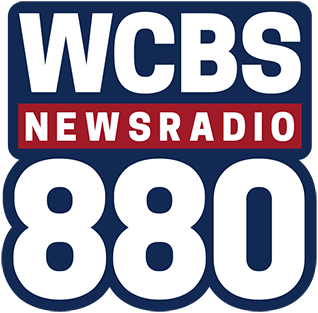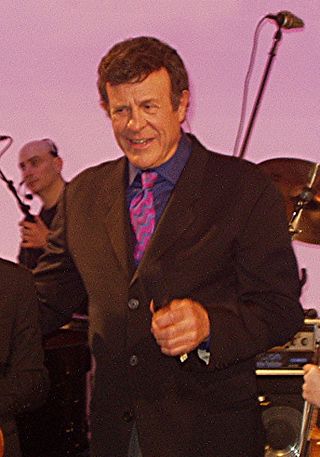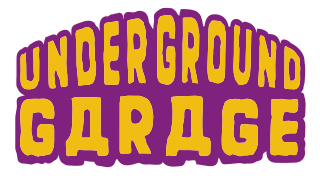
Rockabilly is an early style of rock and roll music. It dates back to the early 1950s in the United States, especially the South. As a genre, it blends the sound of Western musical styles such as country with that of rhythm and blues, leading to what is considered "classic" rock and roll. The term "rockabilly" itself is a portmanteau of "rock" and "hillbilly"; the latter is a reference to country music that contributed strongly to the style. Other important influences on rockabilly include western swing, boogie-woogie, jump blues, and electric blues.

Daniel Snider is an American musician, best known as the lead singer and songwriter of the heavy metal band Twisted Sister. The band's song "We're Not Gonna Take It" reached No. 21 on the Billboard Hot 100 singles chart and was ranked No. 47 on 100 Greatest 80's Songs. Snider later formed and was the lead singer in the heavy metal bands Desperado, Widowmaker, and SMFs. He also released several solo albums. Snider was ranked #83 in the Hit Parader's Top 100 Metal Vocalists of All Time.

Murray Kaufman, professionally known as Murray the K, was an influential New York City rock and roll impresario and disc jockey of the 1950s, '60s and '70s. During the early days of Beatlemania, he frequently referred to himself as the fifth Beatle.
Oldies is a term for musical genres such as pop music, rock and roll, doo-wop, surf music from the second half of the 20th century, specifically from around the mid-1950s to the 1980s, as well as for a radio format playing this music.

Floyd Vivino, also known as Uncle Floyd, is an American television, film, and stage performer primarily known for his comedy/variety TV show The Uncle Floyd Show (1974–1998).
WABC is a commercial radio station licensed to New York City, carrying a conservative talk radio format known as "Talkradio 77". Owned by John Catsimatidis' Red Apple Media, the station's studios are located in Red Apple Media headquarters on Third Avenue in Midtown Manhattan and its transmitter is in Lodi, New Jersey. Its 50,000-watt non-directional clear channel signal can be heard at night throughout much of the Eastern United States and Eastern Canada. It is the primary entry point for the Emergency Alert System in the New York metropolitan area and New Jersey. WABC simulcasts on WLIR-FM in Hampton Bays, New York, on eastern Long Island.

WNYW is a television station in New York City, serving as the flagship of the Fox network. It is owned and operated by the network's Fox Television Stations division alongside Secaucus, New Jersey–licensed MyNetworkTV flagship WWOR-TV. The two stations share studios at the Fox Television Center on East 67th Street in Manhattan's Lenox Hill neighborhood; WNYW's transmitter is located at One World Trade Center.
WLNY-TV, branded as New York 55, is an independent television station licensed to Riverhead, New York, United States, serving the New York City television market. It is owned by the CBS News and Stations group alongside CBS flagship WCBS-TV. The two stations share studios within the CBS Broadcast Center on West 57th Street in Midtown Manhattan; WLNY-TV's transmitter is located in Ridge, New York. The station's over-the-air broadcast covers most of Long Island, but WLNY-TV is available on cable and satellite systems throughout the New York City market.

WCBS is a radio station licensed to New York, New York, owned and operated by Audacy, Inc. WCBS's studios are located in the combined Audacy facility in the Hudson Square neighborhood of Lower Manhattan and its transmitter site is located on High Island in the Bronx. Its 50,000-watt clear channel signal can be heard at night throughout much of the eastern United States and Canada.

WCBS-FM is a radio station owned and operated by Audacy, Inc. licensed to New York, New York, and broadcasting a classic hits format. The station's studios are in the combined Audacy facility in the Hudson Square neighborhood in Lower Manhattan, and its transmitter is located at the Empire State Building.
WFAN-FM, is a commercial radio station licensed to New York City. Owned by Audacy, Inc., the station simulcasts a sports radio format known as "Sports Radio 66 AM and 101.9 FM", or "The FAN", along with co-owned WFAN 660 AM. Its studios are in the Audacy facility in the Hudson Square neighborhood of Lower Manhattan.

Bruce Morrow is an American radio performer, publicly known as Cousin Brucie or Cousin Bruce Morrow. In an October 2020 interview, Morrow said he received the moniker "Cousin" while in the lobby of his midtown Manhattan WABC studio when an elderly woman once asked him "Cousin, lend me fifty cents to get home" to whom he did give that fifty cents. The name stuck for six decades.
Don Bombard, known professionally as Bob Shannon, was an American radio disc jockey best known for his work on WCBS-FM in New York City. He was also the author of the book Behind The Hits: Inside Stories of Classic Pop and Rock and Roll.

Underground Garage is the name shared by two related, but different radio outlets that present Rock 'n' Roll and Garage Rock on radio: a syndicated show and a satellite radio station. Steven Van Zandt, best known as a guitarist in Bruce Springsteen & The E Street Band, is the founder and supervisor of both outlets. Both play a mixture of past and current Garage Rock, and feature one song as "The Coolest Song in the World This Week.’’

Robert Gordon was an American rockabilly singer.

Mary Joan Okum, known by her performing name Bonnie Lou, was an American musical pioneer, recognized as one of the first female rock and roll singers. She is also one of the first artists to gain crossover success from country music to rock and roll. She was the "top name" on the first country music program regularly broadcast on a national TV network. Bonnie Lou was one of the first female co-hosts of a successful syndicated television talk show, and a regular musical performer on popular shows in the 1960s and 1970s. She "was a prime mover in the first days of rockabilly," and is a member of the Rockabilly Hall of Fame.
WLIR was a radio station that played a new music/modern rock format on the frequencies 92.7 FM, 98.5 FM, and 107.1 FM from the 1980s into the 2000s. Bob Wilson, longtime WLIR employee and historian, created the website WDAREFM.COM, which maintains the spirit of the original WLIR. He also programs the music playlist. The website broadcasts a mix of alternative rock from the past and present day, along with former WLIR/WDRE personalities, such as Larry The Duck, Drew Kenyon, Andre, and Rob Rush.

The News 12 Networks are a group of regional cable news television channels in the New York metropolitan area that are owned by Altice USA. All channels provide rolling news coverage 24 hours a day, focusing primarily on regions of the metro area outside Manhattan, Queens, and Staten Island.
Pat St. John is an American radio personality and voice-over artist. He began his radio career on Windsor, Ontario's CKLW in 1969 and 1970, followed by WKNR in late 1970 to early 1972, followed by WRIF FM (101.1) to April 1973. St. John is best known for the 42 years he spent in the New York City radio market working for WPLJ, WNEW-FM, WAXQ and WCBS FM. He can now be heard on Sirius XM Radio '60s Gold Weekdays 3PM to 7 PM ET and Saturdays from 8-11PM ET. St. John has done television voiceover work, including announcing for Dick Clark's New Year's Rockin' Eve from 2000 to 2010.
WNYT is the college radio station for the New York Institute of Technology. It is available via Internet radio, and heard at various places on NYIT's campus.












